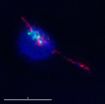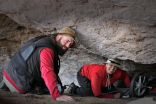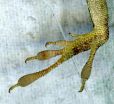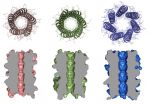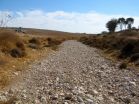Genetic causes underlying the disqualification of 2 elite American Standardbred pacers
2014-10-23
(Press-News.org) A DNA mutation that can lead to horses being genetically male, but female in appearance, may explain at least two cases of controversial sexual identity, according to research led by professors from the Texas A&M College of Veterinary Medicine & Biomedical Sciences (CVM) and published in PLOS Genetics.
This type of genetic abnormality is caused by a mutation called DNA copy number variation (CNV), in which there are deletions and duplications in the genome typically larger than 50 base pairs.
These variations are one way that individuals of the same species are genetically different from one another, and although these mutations contribute to diversity and adaptations, they can sometimes cause diseases and disorders
The international team of researchers studied the genomes of 38 normal horses of 16 diverse breeds and identified 258 regions with CNV. "The resulting dataset of nearly 1500 CNVs is a critical resource for any CNV research in horses in the future," said Dr. Terje Raudsepp, an associate professor at the CVM and principal investigator for the study. Contrary to their expectations, the researchers found only two breed-specific CNVs. "We had to remove the tag 'breed specific' from almost all previously published horse CNVs," said Raudsepp, "but like cattle, dogs, and pigs; horses too might have breed-specific variants. It is just that their discovery requires analysis of even larger and more diverse populations."
The team also carried out detailed analysis of CNV genes and concluded that the overall pattern observed in horses is similar to that known in humans and other mammals. CNVs tend to involve genes for sensory perception, immunity and reproduction.
In addition to the phenotypically normal horses, the team also analyzed CNVs in a group of horses with disorders of sexual development. Among these were two elite American Standardbred pacers who were disqualified from races in female category due to controversial sexual identity. These two horses are male pseudo-hermaphrodites. In other words, they are female in appearance, but have hidden rudimentary testicles and the male-specific Y chromosome. Both were found to have a large deletion interrupting a cluster of genes that are necessary for sex hormone metabolism and sexual development.
"In order to distinguish between normal and disease-related variants, detailed knowledge about CNVs in the species of interest is needed," said Raudsepp. "Our goal was to both carry out a thorough 'inventory' of previously reported CNVs and to discover new ones, in order to create a whole-genome platform for the study of CNVs in horses." Such an inventory then makes it easier to find variants that distinguish horse breeds from one another, as well as to find which mutations lead to which traits.
"Our findings provide the first hints about likely molecular causes and the involvement of CNVs in equine disorders of sexual development," Raudsepp said. "As similar conditions are also known in humans and other mammals, the findings might have biomedical significance far beyond their importance in horse racing."
INFORMATION:
ELSE PRESS RELEASES FROM THIS DATE:
2014-10-23
Kansas City, MO. — The development of a new organism from the joining of two single cells is a carefully orchestrated endeavor. But even before sperm meets egg, an equally elaborate set of choreographed steps must occur to ensure successful sexual reproduction. Those steps, known as reproductive cell division or meiosis, split the original number of chromosomes in half so that offspring will inherit half their genetic material from one parent and half from the other.
During meiosis, each set of homologous chromosomes pair up in a kind of chromosomal square dance, ...
2014-10-23
An international team of researchers from Japan and the UK has discovered how a single protein, called PP4, oversees the processing of DNA during sperm and egg generation for successful fertilization. This protein's activity becomes even more paramount during aging. The study, published in the journal PLOS Genetics, may one day help scientists to understand the mechanisms underlying age-related fertility declines in humans.
While a typical adult human cell contains 46 DNA strands, or chromosomes, that carry our complete genetic information, reproductive cells such as ...
2014-10-23
Research conducted at the highest-altitude Pleistocene archaeological sites yet identified in the world sheds new light on the capacity of humans to survive in extreme environments.
The findings, to be published in the Oct. 24 edition of the academic journal Science – co-authored by a team of researchers including University of Calgary archaeologist Sonia Zarrillo – were taken from sites in the Pucuncho Basin, located in the Southern Peruvian Andes.
The primary site, Cuncaicha is a rock shelter at 4,480 metres above sea level, with a stone-tool workshop ...
2014-10-23
Scientists working on islands in Florida have documented the rapid evolution of a native lizard species — in as little as 15 years — as a result of pressure from an invading lizard species, introduced from Cuba.
After contact with the invasive species, the native lizards began perching higher in trees, and, generation after generation, their feet evolved to become better at gripping the thinner, smoother branches found higher up.
The change occurred at an astonishing pace: Within a few months, native lizards had begun shifting to higher perches, and over ...
2014-10-23
When a solid material is immersed in a liquid, the liquid immediately next to its surface differs from that of the bulk liquid at the molecular level. This interfacial layer is critical to our understanding of a diverse set of phenomena from biology to materials science. When the solid surface is charged, just like an electrode in a working battery, it can drive further changes in the interfacial liquid. However, elucidating the molecular structure at the solid-liquid interface under these conditions has proven difficult.
Now, for the first time, researchers at the US ...
2014-10-23
Ferns are believed to be 'old' plant species – some of them lived alongside the dinosaurs, over 200 million years ago. However, a group of Andean ferns evolved much more recently: their completely new form and structure (morphology) arose and diversified within the last 2 million years. This novel morphology seems to have been advantageous when colonising the extreme environment of the high Andes.
Dr Patricia Sanchez-Baracaldo (Bristol) and Dr Gavin Thomas (Sheffield) used molecular and morphological data to study a group of ferns which grow in a unique ecosystem ...
2014-10-23
Proteins are long linear molecules that fold up to form well-defined 3D shapes. These 3D molecular architectures are essential for biological functions such as the elasticity of skin, the digestion of food, and the transport of oxygen in blood.
Despite the wide variety of tasks that natural proteins perform, they appear to use only a limited number of structural types, perhaps just a few thousand or so. These are used over and over again, being altered and embellished through evolution to generate many different functions. This raises the question: are more protein ...
2014-10-23
A Dartmouth study suggests that it may be possible to use Diffuse Optical Spectroscopic Tomographic imaging (DOST) to predict which patients will best respond to chemotherapy used to shrink breast cancer tumors before surgery. These findings could eliminate delays in effective early treatment for tumors unlikely to respond to neoadjuvant chemotherapy (NAC). The study, "Predicting breast tumor response to neoadjuvant chemotherapy with Diffuse Optical Spectroscopic Tomography prior to treatment," was published online in Clinical Cancer Research on October 7, 2014.
Breast ...
2014-10-23
BOSTON - New achievements in synthetic biology announced today by researchers at the Wyss Institute for Biologically Inspired Engineering, which will allow complex cellular recognition reactions to proceed outside of living cells, will dare scientists to dream big: there could one day be inexpensive, shippable and accurate test kits that use saliva or a drop of blood to identify specific disease or infection — a feat that could be accomplished anywhere in the world, within minutes and without laboratory support, just by using a pocket–sized paper diagnostic ...
2014-10-23
(Santa Barbara, Calif.) — Volatile rainstorms drive complex landscape changes in deserts, particularly in dryland channels, which are shaped by flash flooding. Paradoxically, such desert streams have surprisingly simple topography with smooth, straight and symmetrical form that until now has defied explanation.
That paradox has been resolved in newly published research conducted by Michael Singer and Katerina Michaelides, associate researchers at UC Santa Barbara's Earth Research Institute. The pair show that simple topography in dryland channels is maintained ...
LAST 30 PRESS RELEASES:
[Press-News.org] Genetic causes underlying the disqualification of 2 elite American Standardbred pacers
